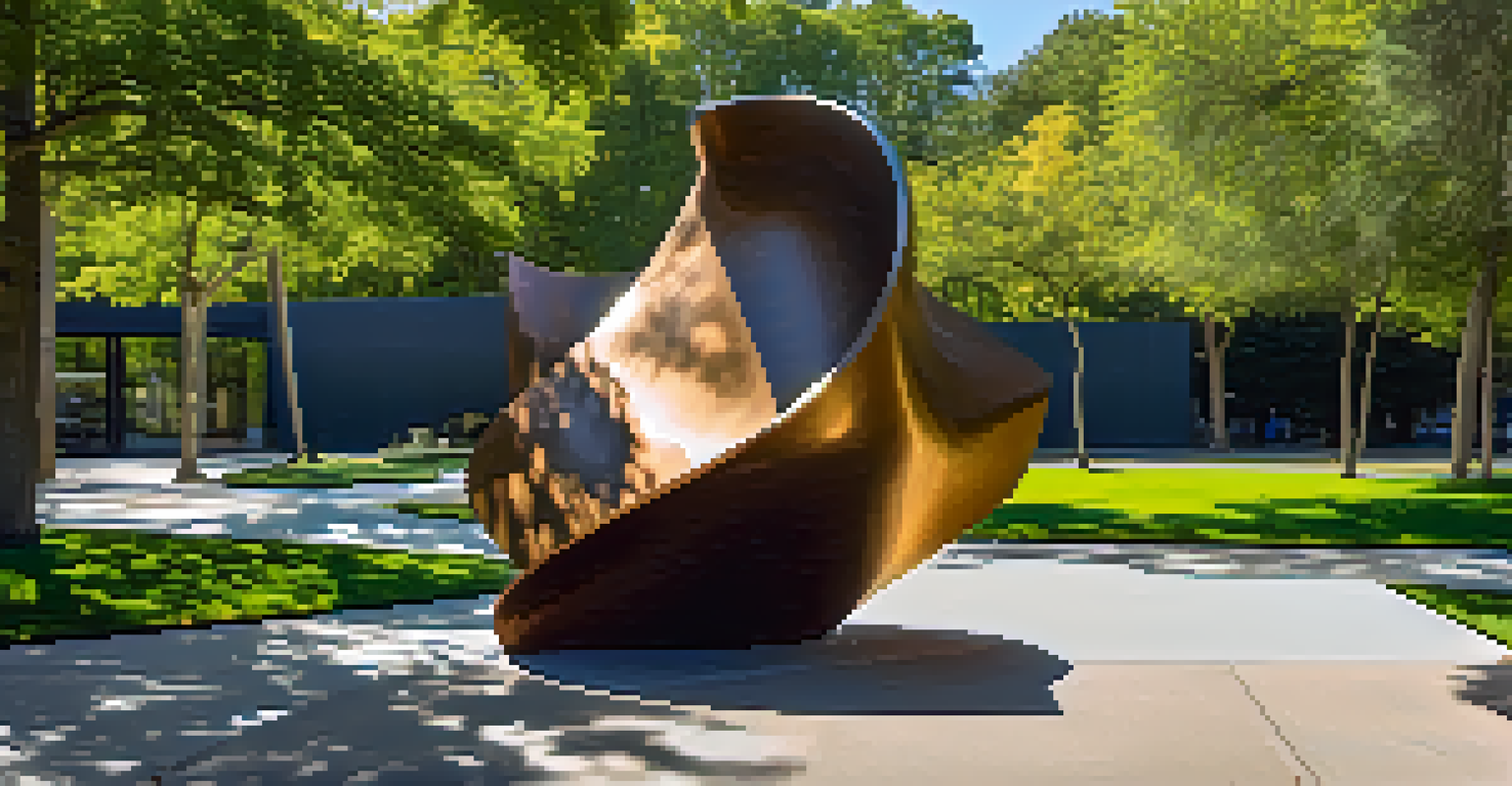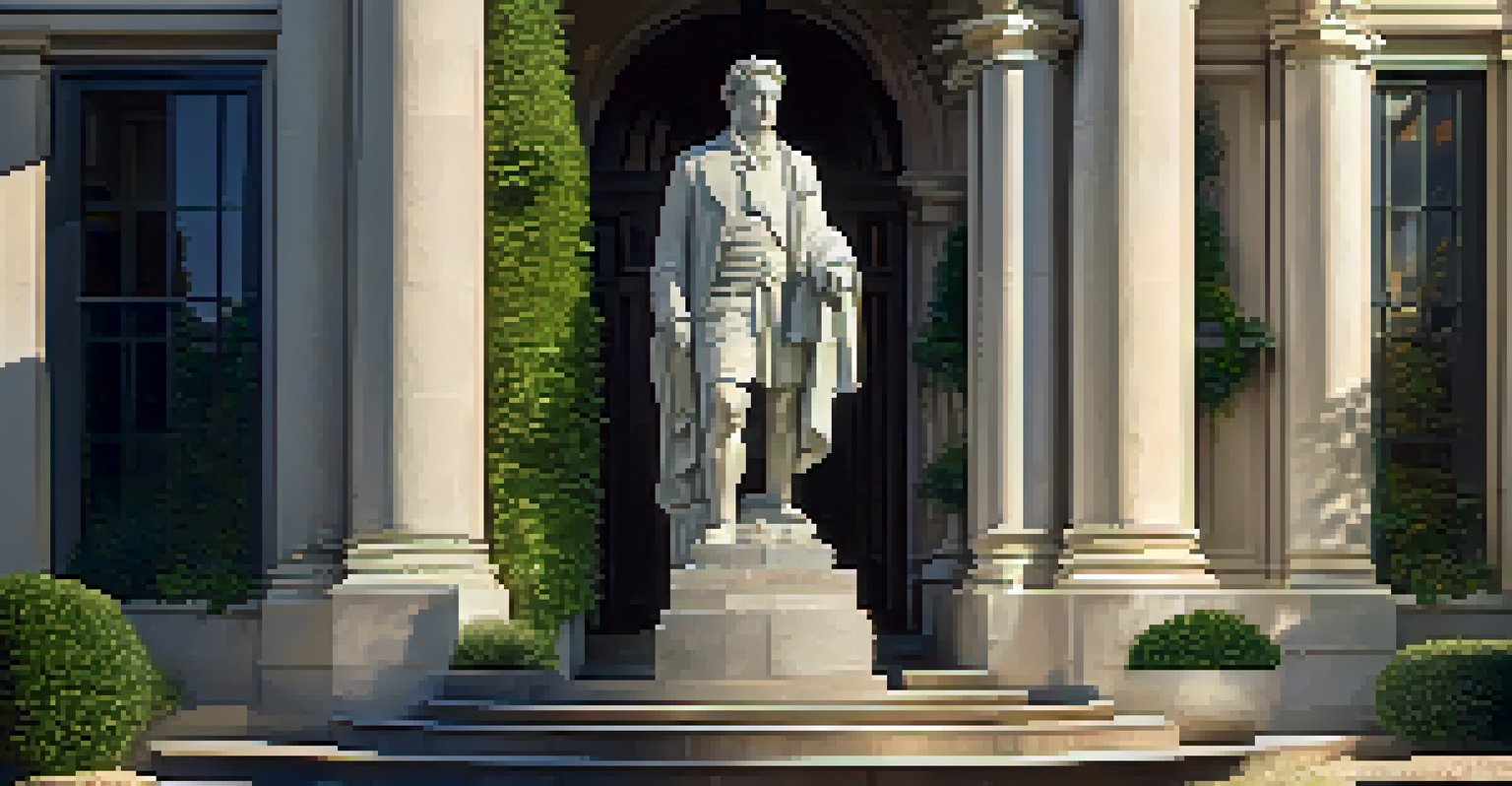Understanding Proportion in Sculpture: Key Concepts

What is Proportion in Sculpture and Why It Matters
Proportion in sculpture refers to the relationship between different parts of a sculpture and how they relate to the whole. It’s crucial because it affects how we perceive the piece, influencing our emotional and aesthetic response. Just like in a well-composed photograph, where the size of elements creates balance, proportion in sculpture helps achieve harmony and unity.
Proportion is the soul of beauty.
When artists carefully consider proportion, they can create works that feel natural and engaging. For example, think of the famous sculptures of Michelangelo, where the human body is depicted with such an understanding of proportion that they almost breathe with life. Without proper proportion, a sculpture can feel off-balance, awkward, or even unsettling.
In essence, proportion is the backbone of sculptural design. It guides artists in crafting pieces that resonate with viewers, making it a fundamental concept in the world of sculpture. Understanding this can greatly enhance one's appreciation of art and the skill behind it.
Types of Proportion: Relative vs. Absolute
In the realm of sculpture, proportion can be categorized into two main types: relative and absolute. Relative proportion refers to the size relationship between different elements within a sculpture, while absolute proportion relates to the size of the sculpture as a whole compared to the actual human body or other familiar objects. This distinction helps artists communicate ideas and themes effectively.

For instance, a sculptor might exaggerate certain features, like large hands or a big head, to convey strength or power, which is a form of relative proportion. On the other hand, absolute proportion helps the audience relate the sculpture to their own experiences and perceptions. Think of a life-sized statue compared to a larger-than-life piece; the latter invokes a sense of awe and grandeur.
Proportion Shapes Emotional Response
The relationship between different parts of a sculpture influences how we perceive and feel about the artwork.
Understanding these types of proportion can enhance an artist's ability to convey messages through their work. It allows them to play with perceptions and guide emotions, ensuring that each sculpture speaks to its audience in a meaningful way.
The Golden Ratio: Nature’s Ideal Proportion
The Golden Ratio, often represented by the Greek letter Phi (φ), is a mathematical ratio that has been revered for centuries in art and architecture. It’s approximately 1.618 and is believed to represent perfect harmony and balance. Many renowned sculptures, such as those of ancient Greece, have utilized this ratio to create visually pleasing works that resonate deeply with viewers.
The whole is greater than the sum of its parts.
Take, for example, the Parthenon in Athens; its dimensions roughly align with the Golden Ratio, creating an aesthetic appeal that has stood the test of time. Sculptors often apply this principle to achieve a sense of unity and beauty in their pieces. Understanding the Golden Ratio can help artists structure their work in a way that feels naturally appealing.
Incorporating the Golden Ratio into sculpture isn’t just about following a formula; it’s about tapping into a universal language of beauty that many people instinctively appreciate. By doing so, artists can create sculptures that not only capture attention but also evoke a deeper emotional response.
Scale and Its Impact on Perception
Scale in sculpture refers to the size of a sculpture in relation to its environment or to the human body. When artists play with scale, they can create dramatic effects that alter how viewers perceive the work. A small sculpture displayed in a vast space can evoke feelings of intimacy, while a colossal piece can instill a sense of awe and insignificance.
Consider the work of modern artists like Anish Kapoor, who often creates large-scale installations that challenge our perceptions of space. His pieces not only draw attention but also invite viewers to interact with their environment in new ways. The scale can transform a simple idea into a grand statement, making it vital for artists to consider.
Understanding Proportion Types
Artists can use relative and absolute proportion to effectively communicate ideas and themes through their sculptures.
Moreover, the effective use of scale helps convey meaning. For instance, a life-sized sculpture may celebrate the human form, while a larger-than-life depiction might symbolize power or dominance. Thus, understanding scale is essential for sculptors looking to communicate specific emotions and messages through their work.
Symmetry and Asymmetry: Balancing Act
Symmetry and asymmetry are two contrasting approaches to proportion that can dramatically influence the aesthetic of a sculpture. Symmetrical sculptures exhibit balance and harmony, often evoking feelings of calm and order. Think of classical statues that are carefully crafted to mirror each side, creating a sense of stability.
Conversely, asymmetrical sculptures can create dynamic tension and interest, drawing viewers in with their unexpected forms. Artists like Henry Moore often embraced asymmetry, resulting in pieces that feel alive and ever-changing. This approach challenges traditional notions of beauty and encourages exploration of new ideas.
Understanding how to use symmetry and asymmetry allows sculptors to create pieces that resonate on different levels. Whether aiming for tranquility or intrigue, these concepts provide powerful tools for artists to express themselves and connect with their audiences.
The Role of Context in Perceiving Proportion
Context plays a significant role in how proportion is perceived in sculpture. The surroundings, cultural background, and even the time period can influence our understanding of a piece. For instance, a sculpture placed in a historical setting may carry different connotations than the same piece displayed in a modern gallery.
Take the iconic statue of David by Michelangelo: when placed in the context of Renaissance ideals, it embodies humanistic values and perfection. However, if viewed in a contemporary setting, it might evoke discussions around art history and the evolution of beauty standards. This interplay of context and proportion enriches the viewer's experience.
Context Enhances Perception
The surroundings and cultural background significantly influence how we interpret the proportion and meaning of a sculpture.
By considering context, artists can craft sculptures that resonate more deeply with their audiences. This understanding helps sculptors create meaningful connections between their work and the world around them, enhancing the overall impact of their art.
Practical Tips for Applying Proportion in Your Sculpture
For aspiring sculptors looking to master proportion, starting with a few practical tips can be incredibly helpful. First, consider using reference models or sketches to establish relative proportions before beginning your piece. This foundational step can save time and ensure a more cohesive final product, allowing for a clearer vision from the start.
Next, practice measuring and scaling your work throughout the process. Techniques like the use of a grid can help maintain proportional accuracy, especially in complex pieces. This hands-on approach not only hones your skills but also deepens your understanding of how proportion affects the overall impact of your work.

Lastly, don’t shy away from experimenting! Proportion is not a strict rule but rather a guideline that can be bent or broken for artistic expression. By allowing yourself the freedom to explore, you may discover unique ways to engage with proportion that speak to your personal artistic voice.